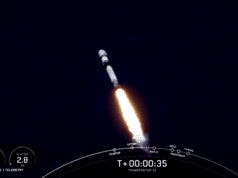Seoul, South Korea, 19 December 2006 – South Korea plans to launch an infrared detection satellite around 2012 that will have both civilian and military applications, a state space panel said on December 19.
The satellite, to be called Arirang 3A, will be an upgraded version of the Arirang 3 and will be equipped with a high resolution multi-spectra camera, the newly formed National Space Council said. As the successor to Arirang-3 scheduled to be launched in 2009, the satellite will be equipped with a 70 cm-grade MSC which shows 70 cm-large objects on the surface and at sea as one pixel. It will also have infrared channels.
The council, chaired by Minister of Science and Technology Kim Woo-sik, said while the multi-spectral camera (MSC) equipped Arirang 3 will have a high resolution of 70-centimeters, the 3A will incorporate the ability to pick up heat as well as take very sharp pictures.
This can be used to fight forest fires, detect heat islands in urban areas during the summer and monitor volcanic activity. The infrared capability can also be used to follow the movement of vehicles, ships and aircraft. The latter function could help national defense policymakers keep track of military activities.
South Korea launched the Arirang 1 satellite in December 1999, followed by the Arirang 2 in July of this year. The former has camera with a resolution of 6 meters on board, and the latter has a camera with a resolution of 1 meter.
The council said a total of 212 billion won (US$228.2 million) will be used to develop the 3A satellite, with local engineers to build an infrared camera and associated devices by 2009.
Once launched, the Arirang 3A will be placed in a low orbit of 450-890 kilometers above the Earth’s surface and be able to screen an area of 16.8 kilometers at every pass. The resolution for black and white photos will be on par with the Arirang 3. The satellite will have an expected life cycle of four years.
An Arirang 5 satellite that is being prepared for launch in 2008 is to be equipped with a radar imaging device that can detect activity on the Earth’s surface at night and in bad weather.
– About National Space Council
The space council is composed of the heads of nine government ministries and the National Intelligence Service. Four civilian experts, including the head of the Korea Aerospace Research Institute and Agency for Defense Development, also sit on the council.




